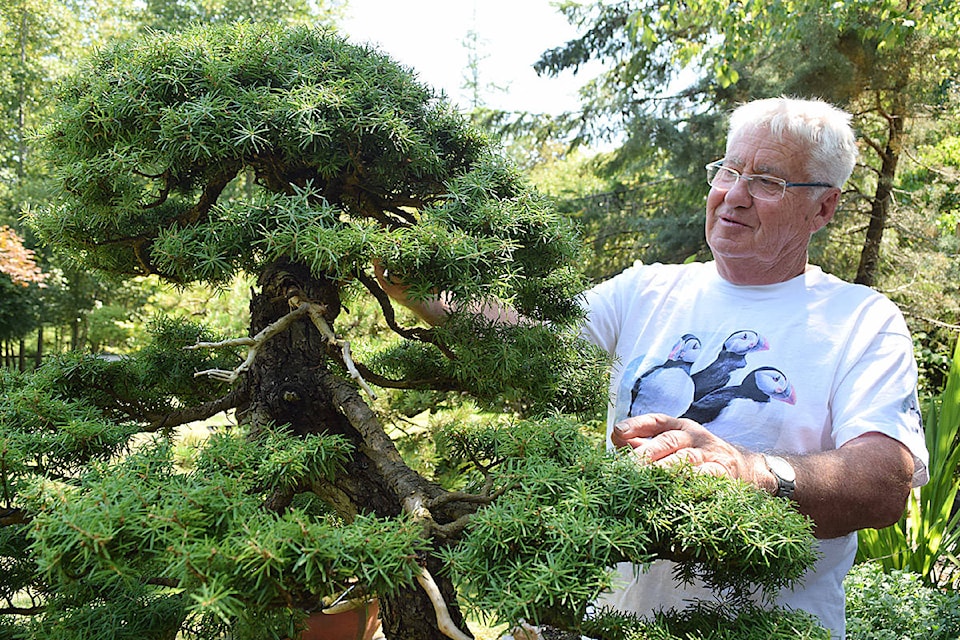Peter Wilson’s garden is something of an art gallery, adorned with an abundance of the small potted trees known as bonsai. Dozens of little shore pines, mountain hemlocks and Western red cedars bedeck the long tables and pedestals of his yard.
The Campbell River man has earned an international reputation as a grower of fine bonsai. Most recently, two of his hemlocks were purchased for a prestigious private collection in Pennsylvania.
“I have [a] very large collection and many imported Japanese hemlocks in my garden and have been looking for some Canadian hemlocks for many years,” said Doug Paul, owner of the Kennett Collection, in an email to the Mirror.
“These will be the finest Canadian mountain hemlocks on the East Coast,” he said, explaining that Wilson has been refining his trees for years.
| Bonsai grower Peter Wilson sold two of his hemlock bonsai trees to a renowned Pennsylvania-based collector, Doug Paul, including this specimen. Photo by David Gordon Koch/Campbell River Mirror |
Indeed, Wilson has been honing his skills as a bonsai grower for over two decades. He only decided to sell some of his larger bonsai because they had grown so heavy that they became hard to lift.
Paul, whose collection is considered one of the world’s finest, purchased the hemlocks through a middleman. When Wilson learned the identity of the buyer, he was shocked.
“He’s got the best trees from all around the world,” said Wilson. “Two of my trees are going there. Are they worthy?”
But he was relieved to know they’d be in good hands.
“They’ll get professional care, that’s what I’m really happy about,” he said as he gazed at one of the two hemlocks, which are due for shipment to the U.S. later this year. “I hope he enjoys them as much as I do.”
For his source materials, Wilson travels along remote logging roads, looking for places where poor soil naturally dwarfs the trees.
He seeks out the ones with strong trunks, carefully removes them from the ground and loads them into his truck. This may involve a hike, since prime locations are often far from the road.
The small size of those dwarfed trees belies their old age. Most of them are centuries old, said Wilson.
Early in the process, the trees are often ugly and gnarled. Wilson gradually shapes them into picturesque miniatures of full-sized trees.
To achieve his vision, he applies ancient bonsai techniques, notably the use of wires to bend branches into the desired position.
It’s an art that requires tremendous patience.
“When you collect ’em, they’re nothing,” he said, gesturing towards a homely specimen.
“But give this one five years and you won’t recognize it. It’ll be a big bushy tree. It’ll take off. But nobody would give you 10 cents for it right now.”
Wilson took up bonsai in 1994. At the time, he lived in Port Alice, on the northern tip of the Island, where he was a pulp mill supervisor. One day he picked up a coffee table book about bonsai and started collecting trees in the bush. The rest is history.
The majestic coastal forests influenced his work, especially on the rugged west coast of the Island.
“It’s just gorgeous,” he said, recalling days spent on his boat or weekends in a rustic cabin with his family.
| Bonsai collector Doug Paul said that bonsai purchased from Campbell River's Peter Wilson will be the finest on the East Coast. Photo by David Gordon Koch/Campbell River Mirror |
He’s largely self-taught, though friends have helped him. There was no Internet in Port Alice, so he would call people on the phone for pointers.
Someone eventually persuaded him to enter the American Bonsai Society’s “new talent” competition in 2003.
He won a trip to Japan, where he attended the Kokufu-ten, an elite bonsai exhibition.
“That was an eye-opener,” he said, noting that the perfection of Japanese bonsai left him feeling discouraged. “I came back to my collection. I thought, I’ll just burn ’em all. But I persevered.”
Asked about advice for newbies, he suggested joining a bonsai club. Stay away from Internet sources, he said. They’re full of misinformation.
Finally, he said, new bonsai enthusiasts should collect their trees from the wild. Look for ones with a good solid trunk.
“The foliage of a tree is today’s news,” he said. “The branches are old news. But the trunk, that’s history.”
